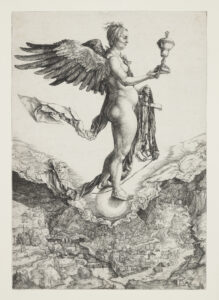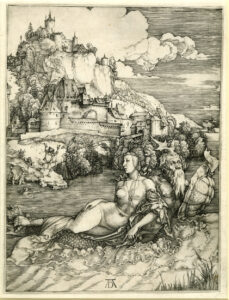At the turn of the 16th century, Nuremberg was at the centre of a Europe revolving rapidly away from the old certainties. A New World was beginning to be mapped out at the far reaches of the Atlantic Ocean, while the theologian Martin Luther was about to hammer 95 nails into the supposed infallibility of the Roman Catholic church. The universe, once so knowable, so reassuringly geocentric, was expanding rapidly as Nicolaus Copernicus’s astronomical theories shunted the Earth into a more humble orbit, secondary to the sun.
It would have been hard to keep pace, as advances in printing sped the propagation of these new ideas like wildfire, fanning their flames to the very edges of the known world. They must have been exciting times for those intoxicated by the possibilities of the new.

Nemesis. Image courtesy of The Whitworth.
Albrecht Dürer was one such neophile, literally as well as figuratively cutting edge in his application of new techniques in etching, new thinking in perspective and new approaches to publishing and marketing his work.
The Whitworth‘s magnificent new retrospective, Albrecht Dürer’s Material World, even at half a millennium’s remove, captures some of the revolutionary spirit of his times by situating the artist’s creations alongside the goods increasingly available to the consumer classes of the city in which he practised. Drawing upon The Whitworth’s own collection of the artist’s works, themselves not displayed together in such numbers for 50 years, and supplemented by loans from the likes of the Ashmolean Museum in Oxford and Manchester’s own John Rylands Library, the exhibition makes the case that an appreciation of Dürer’s incorporation of such consumer durables into his art leads to a more meaningful engagement with it.
This thesis is vividly illustrated in one of his most celebrated prints, the gloriously proto-Gothic (in the sense of Leeds’ dark pop group, The Sisters Of Mercy) Melencolia, in which a winged figure broods, weighted down by the means man has devised to measure out space and time, in the process, perhaps, stripping both of their essence. The heft of the etched timepieces is emphasised by the presence of their three-dimensional counterparts, large as life, in a facing vitrine. Especially striking to 21st century eyes is an early alarm clock, reminding the viewer that the mercantile demand that life be lived by the hours of the working day has a history that long predates the Industrial Revolution.

The Sea Monster. Image courtesy of The Whitworth.
Painted in light, in a manner in which you could imagine it meeting Dürer’s fascinated approval, through the digital technology of the present day, is The Triumphal Arch constructed of prints commissioned by the Holy Roman Emperor, Maximilian I. Projected at its impressive original scale, a monoglot Babel and imperial propaganda piece made up from three dozen individual sheets of paper, the constituent pieces (crafted by Dürer and his pupils) are also projected separately, so that the skill exhibited in crafting each part can be appreciated in isolation from the whole.
Beautifully considered, every minute of the five years’ research underpinning the composition of this enthralling exhibition is manifest in its Dürer-like attention to detail. These details, moreover, are themselves so rich that they demand and amply repay repeated attention, including further consideration at the pace of a sundial or a sandglass. In that respect, at least, the prints are of a time unencumbered by the nagging distractions of portable screens. In every other, in the breathtaking audacity with which Dürer’s art pursues the endless possibilities of a century in which prevailing orthodoxies are pushed to breaking point at accelerating speed, they are very much of our own.
After all, in the words of Madonna, we, too, are living in a material world.
Main image: Saint Anthony Before the Town. Image courtesy of The Whitworth, Manchester.
Albrecht Dürer’s Material World is at The Whitworth, Manchester until March 10, 2024. For more information, click here.








